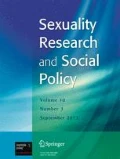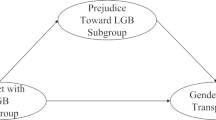Abstract
Introduction
While numerous studies have focused on heterosexuals’ attitudes toward lesbian, gay, and bisexual (LGB) individuals, few studies have examined ally behaviors and their predictors. The present study aimed to model the connections between LGB interpersonal contact and heterosexism in relation to ally behaviors among heterosexuals.
Methods
Heterosexual adults (n = 333) completed an online survey assessing interpersonal contact with LGB individuals, heterosexism, and ally behaviors.
Results
A good-fitting structural equation model showed significant direct effects (all ps < 0.001) from LGB contact to heterosexism (β = − 450), from heterosexism to ally behaviors (β = − 0.280), and from LGB contact to ally behaviors (β = 0.594). There was a significant indirect (mediational) effect from LGB contact to ally behaviors through heterosexism (β = 0.126, p = .001).
Conclusion
The results inform targets for interventions with heterosexuals, such as the facilitation of interpersonal contact between LGB and heterosexuals to reduce prejudice and increase ally behaviors.

Similar content being viewed by others
References
Allport, G. W. (1954). The nature of prejudice. Addison-Wesley.
Aosved, A. C., Long, P. J., & Voller, E. K. (2009). Measuring sexism, racism, sexual prejudice, ageism, classism, and religious intolerance: the intolerant schema measure. Journal of Applied Social Psychology, 39(10), 2321–2354.
Arbuckle, J. L. (2013). IBM SPSS Amos 22 user’s guide. Amos Development Corporation.
Athanases, S. Z., & Larrabee, T. G. (2003). Toward a consistent stance in teaching for equity: Learning to advocate for lesbian-and gay-identified youth. Teaching and Teacher Education, 19, 237–261.
Balsam, K. F., Rothblum, E. D., & Beauchaine, T. P. (2005). Victimization over the life span: A comparison of lesbian, gay, bisexual, and heterosexual siblings. Journal of Consulting and Clinical Psychology, 73, 477–487.
Bishop, A. (2002). Becoming an ally: Breaking the cycle of oppression in people (2nd ed.). Fernwood.
Broido, E. M. (2000). The development of social justice allies during college: A phenomenological investigation. Journal of College Student Development, 41, 3–18.
Brown, M. J., & Henriquez, E. (2008). Socio-demographic predictors of attitudes towards gays and lesbians. Individual Differences Research, 6, 193–202.
Burks, A. C., Cramer, R. J., Henderson, C. E., Stroud, C. H., Crosby, J. W., & Graham, J. (2018). Frequency, nature, and correlates of hate crime victimization experiences in an urban sample of lesbian, gay, and bisexual community members. Journal of Interpersonal Violence, 33(3), 402–420.
Byrne, B. M. (1994). Structural equation modeling with EQS and EQS/windows. Sage Publications.
Cattell, R. (1966). The scree test for the number of factors. Multivariate Behavioral Research, 1, 245–276.
Chizhik, E. W., & Chizhik, A. W. (2002). Decoding the language of social justice: what do “privilege” and “oppression” really mean? Journal of College Student Development, 43, 792–807.
Cooper, J., & Jones, E. E. (1969). Opinion divergence as a strategy to avoid being miscast. Journal of Personality and Social Psychology, 13, 23–30.
Davies, M. (2004). Correlates of negative attitudes toward gay men: Sexism, male role norms, and male sexuality. Journal of Sex Research, 41, 259–266.
Dejowski, E. F. (1992). Public endorsement of restrictions on three aspects of free expression by homosexuals: Socio-demographic and trends analysis 1973-1988. Journal of Homosexuality, 23, 1–18.
Diaz, R. M., Ayala, G., Bein, E., Henne, J., & Marin, B. V. (2001). The impact of homophobia, poverty, and racism on the mental health of gay and bisexual Latino men: Findings from 3 US cities. American Journal of Public Health, 91, 927–932.
Drabble, L. A., Midanik, L. T., & Trocki, K. (2005). Reports of alcohol consumption and alcohol-related problems among homosexual, bisexual and heterosexual respondents: Results from the 2000 National Alcohol Survey. Journal of Studies on Alcohol, 70, 111–120.
Durso, L. E., & Meyer, I. H. (2013). Patterns and predictors of disclosure of sexual orientation to healthcare providers among lesbians, gay men, and bisexuals. Sexuality Research and Social Policy, 10, 35–42.
Eliason, M. (1995). Accounts of sexual identity formation in heterosexual students. Sex Roles, 32, 821–834.
Erickson-Schroth, L., Wu, S. X., & Glaeser, E. (2020). Sexual and gender-based violence in lesbian, gay, bisexual, transgender, and queer communities. In V. Ades (Ed.), Sexual and gender-based violence (pp. 113–126). Cham: Springer.
Federal Bureau of Investigation. (2018). 2018 hate crime statistics. https://ucr.fbi.gov/hate-crime/2018/tables/table-1.xls.
Feinstein, B. A., Goldfried, M. R., & Davila, J. (2012). The relationship between experiences of discrimination and mental health among lesbians and gay men: An examination of internalized homonegativity and rejection sensitivity as potential mechanisms. Journal of Consulting and Clinical Psychology, 80, 917–927.
Fingerhut, A. W. (2011). Straight allies: What predicts heterosexuals’ alliance with the LGBT community? Journal of Applied Social Psychology, 41(9), 2230–2248.
Finkel, M. J., Storaasli, R. D., Bandele, A., & Schaefer, V. (2003). Diversity training in graduate school: An exploratory evaluation of the safe zone project. Professional Psychology: Research and Practice, 34(5), 555–561.
Geasler, M. J., Croteau, J. M., Heineman, C. J., & Edlund, C. J. (1995). A qualitative study of students' expressions of change after attending panel presentations by lesbian, gay, and bisexual speakers. Journal of College Student Development, 36, 483–492.
Gonzalez, K. A., Riggle, E. D. B., & Rostosky, S. S. (2015). Cultivating positive feelings and attitudes: A path to prejudice reduction and ally behavior. Translational Issues in Psychological Science, 1(4), 372–381.
Goodman, D. J. (2001). Promoting diversity and social justice: Educating people from privileges groups. Sage.
Hardiman, R., & Jackson, B. W. (1997). Conceptual foundations for social justice courses. In M. Adams, L. A. Bell, & P. Griffin (Eds.), Teaching for diversity and social justice: A sourcebook. Routledge.
Harrison, A. E., & Silenzio, V. M. (1996). Comprehensive care of lesbian and gay patients and families. Primary Care: Clinics in Office Practice, 23, 31–46.
Hatzenbuehler, M. L., McLaughlin, K. A., Keyes, K. M., & Hasin, D. S. (2010). The impact of institutional discrimination on psychiatric disorders in lesbian, gay, and bisexual populations: A prospective study. American Journal of Public Health, 100(3), 452–459.
Heinze, J. E., & Horn, S. S. (2009). Intergroup contact and beliefs about homosexuality in adolescence. Journal of Youth and Adolescence, 38, 937–951.
Herek, G. M. (2009). Hate crimes and stigma-related experiences among sexual minority adults in the United States prevalence estimates from a national probability sample. Journal of Interpersonal Violence, 24, 54–74.
Herek, G. M., & Capitanio, J. P. (1996). “Some of my best friends”: Intergroup contact, concealable stigma, and heterosexuals’ attitudes toward gay men and lesbians. Personality and Social Psychology Bulletin, 22, 412–424.
Herek, G. M., Gillis, J. R., & Cogan, J. C. (1999). Psychological sequelae of hate-crime victimization among lesbian, gay, and bisexual adults. Journal of Consulting and Clinical Psychology, 67, 945–951.
Herek, G. M., & Glunt, E. K. (1993). Interpersonal contact and heterosexuals’ attitudes toward gay men: Results from a national survey. Journal of Sex Research, 30, 239–244.
Hicks, G. R., & Lee, T. T. (2006). Public attitudes toward gays and lesbians: Trends and predictors. Journal of Homosexuality, 51, 57–77.
Hinrichs, D. W., & Rosenberg, P. J. (2002). Attitudes toward gay, lesbian, and bisexual persons among heterosexual liberal arts college students. Journal of Homosexuality, 43, 61–84.
Hu, L. T., & Bentler, P. M. (1995). Evaluating model fit. In R. H. Hoyle (Ed.), Structural equation modeling: Concepts, issues, and applications (pp. 76–99). Sage.
Huebner, D. M., Rebchook, G. M., & Kegeles, S. M. (2004). Experiences of harassment, discrimination, and physical violence among young gay and bisexual men. American Journal of Public Health, 94, 1200–1203.
Irwin, J. (2002). Discrimination against gay men, lesbians, and transgender people working in education. Journal of Gay and Lesbian Social Services, 14, 65–77.
Jones, S. R., & McEwen, M. K. (2000). A conceptual model of multiple dimensions of identity. Journal of College Student Development, 41, 405–414.
Kenny, D. A. (2014). Measuring model fit. http://davidakenny.net/cm/fit.htm.
Kite, M. E., & Whitley, B. E. (1996). Sex differences in attitudes toward homosexual persons, behaviors, and civil rights a meta-analysis. Personality and Social Psychology Bulletin, 22, 336–353.
Lehavot, K., & Simoni, J. M. (2011). The impact of minority stress on mental health and substance use among sexual minority women. Journal of Consulting and Clinical Psychology, 79, 159–170.
Mays, V. M., & Cochran, S. D. (2001). Mental health correlates of perceived discrimination among lesbian, gay, and bisexual adults in the United States. American Journal of Public Health, 91(11), 1869–1876.
McCabe, S. E., Hughes, T. L., Bostwick, W. B., West, B. T., & Boyd, C. J. (2009). Sexual orientation, substance use behaviors and substance dependence in the United States. Addiction, 104, 1333–1345.
Moeschberger, S. L., Ordonez, A., Shankar, J., & Raney, S. (2006). Moving from contact to change. In R. L. Toporek, L. H. Gerstein, N. A. Fouad, G. Roysircar, & T. Israel (Eds.), Handbook for social justice in counseling psychology: Leadership, vision, and action (pp. 472–486). Sage.
Nelson, E. S., & Krieger, S. L. (1997). Changes in attitudes toward homosexuality in college students: Implementation of a gay men and lesbian peer panel. Journal of Homosexuality, 33, 63–81.
Ostrove, J. M., & Brown, K. T. (2018). Are allies who we think they are? A comparative analysis. Journal of Applied Social Psychology, 48(4), 195–204.
Pittinsky, T. L., Rosenthal, S. A., & Montoya, R. M. (2011). Liking is not the opposite of disliking: The functional separability of positive and negative attitudes toward minority groups. Cultural Diversity and Ethnic Minority Psychology, 17(2), 134–143.
Poteat, V. P. (2015). Individual psychological factors and complex interpersonal conditions that predict LGBT-affirming behavior. Journal of Youth and Adolescence, 44(8), 1494–1507.
Resnick, C. A., & Galupo, M. P. (2019). Assessing experiences with LGBT microaggressions in the workplace: Development and validation of the microaggression experiences at work scale. Journal of Homosexuality, 66(10), 1380–1403.
Roades, L. A., & Mio, J. S. (2000). Allies: How they are created and what are their experiences? In Resistance to multiculturalism: Issues and interventions (pp. 63–82). Brunner/Mazel.
Schope, R. D., & Eliason, M. J. (2000). Thinking versus acting: assessing the relationship between heterosexual attitudes and behaviors toward homosexuals. Journal of Gay and Lesbian Social Services, 11(4), 69–92.
Smith, S. J., Axelton, A. M., & Saucier, D. A. (2009). The effects of contact on sexual prejudice: A meta-analysis. Sex Roles, 61, 178–191.
Swank, E., & Fahs, B. (2012). Resources, social networks, and collective action frames of college students who join the gay and lesbian rights movement. Journal of Homosexuality, 59(1), 67–89.
Swank, E., Woodford, M. R., & Lim, C. (2013). Antecedents of pro-LGBT advocacy among sexual minority and heterosexual college students. Sexuality Research and Social Policy, 10(4), 317–332.
Swim, J. K., Ferguson, M. J., & Hyers, L. L. (1999). Avoiding stigma by association: Subtle prejudice against lesbians in the form of social distancing. Basic and Applied Social Psychology, 21(1), 61–68.
Tabachnick, B. G., & Fidell, L. S. (2001). Using multivariate statistics (4th ed.). Allyn & Bacon.
Waterman, A. D., Reid, J. D., Garfield, L. D., & Hoy, S. J. (2001). From curiosity to care: Heterosexual student interest in sexual diversity courses. Teaching of Psychology, 28, 21–26.
Wood, P. B., & Bartkowski, J. P. (2004). Attribution style and public policy attitudes toward gay rights. Social Science Quarterly, 85, 58–74.
Zeeman, L., Sherriff, N., Browne, K., McGlynn, N., Mirandola, M., Gios, L., et al. (2019). A review of lesbian, gay, bisexual, trans and intersex (LGBTI) health and healthcare inequalities. European Journal of Public Health, 29(5), 974–980.
Author information
Authors and Affiliations
Corresponding author
Ethics declarations
Conflict of Interest
The authors declare that they have no conflicts of interest.
Ethical Approval
All procedures performed in studies involving human participants were in accordance with the ethical standards of the institutional and/or national research committee and with the 1964 Helsinki declaration and its later amendments or comparable ethical standards.
Informed Consent
Informed consent was obtained from all individual participants included in the study.
Additional information
Publisher’s Note
Springer Nature remains neutral with regard to jurisdictional claims in published maps and institutional affiliations.
Rights and permissions
About this article
Cite this article
Henry, R.S., Smith, E.R., Perrin, P.B. et al. Structural Equation Model Predicting LGB Ally Behaviors in Heterosexuals. Sex Res Soc Policy 18, 331–338 (2021). https://doi.org/10.1007/s13178-020-00461-x
Published:
Issue Date:
DOI: https://doi.org/10.1007/s13178-020-00461-x



